Iulia Stānoiu / Context.ro
Eva Stefankova / Investigative Center of Jan Kuciak
Josef Slerka / Investigace.cz
Kaili Malts / Delfi
Petra Blum / Westdeutscher Rundfunk (WDR)
Zalán Zubor / Atlatszo
Illustration: Aleksandra Ołdak 2024-07-03
Iulia Stānoiu / Context.ro
Eva Stefankova / Investigative Center of Jan Kuciak
Josef Slerka / Investigace.cz
Kaili Malts / Delfi
Petra Blum / Westdeutscher Rundfunk (WDR)
Zalán Zubor / Atlatszo
Illustration: Aleksandra Ołdak 2024-07-03
TikTok feeds in Central Eastern European countries, including the Czech Republic, Slovakia, Estonia, Romania and Poland, have been filled with conspiracy theories and fear-mongering resembling Russian disinformation — and to the benefit of the far-right.
🇩🇪Germany’s huge TikTok market is vulnerable to extremists’ tactics, which have gained major traction with young voters. Our cross-border investigation proved that you can easily buy virality on social networks.
🇷🇴In Romania, reporters showed that the social network was a key platform for emerging far-right political figures.
🇵🇱Similarly, in Poland, the TikTok champions of the European Parliament elections were the far-right, who are now heading to Brussels.
🇸🇰In Slovakia, TikTok served as a fertile ground for conspiracies about the attempted assassination of Prime Minister Robert Fico.
🇨🇿Meanwhile, in the Czech Republic, reporters found that the platform’s algorithm was pushing users into a bubble of disinformation.
🇪🇪Estonians were exposed to fear-mongering related to war that was propagated through TikTok.
🇭🇺 In Hungary, Russian narratives flow to TikTok via public media.
German TikTok, the playground of right-wing extremists
The German TikTok scene has become a hub for right-wing extremists. A recent investigation found that it’s easy to buy popularity on the platform, which boasts 23 million users in Germany. Journalists created a basic account and engaged with popular live-streams to test the system. Soon enough, they were offered a thousand followers to boost their account and activate the live stream feature. However, there are doubts about the authenticity of these followers, as they may be automated bots.
Although TikTok claims to have safety protocols in place, analysts have criticized the platform for allowing fake accounts to manipulate user engagement and content virality. In Germany, the right-wing party AfD seems to be taking advantage of this. AfD has a strong pro-Russian stance, and its politicians have been endorsed by Russian President Vladimir Putin. The party’s content performed exceptionally well on TikTok, especially in the months leading up to the European Election. Analysis shows that AfD’s content received significantly more views and interaction than that of other competing parties. A key demographic for AfD on TikTok is teenagers — who are now eligible to vote in Germany’s European elections.
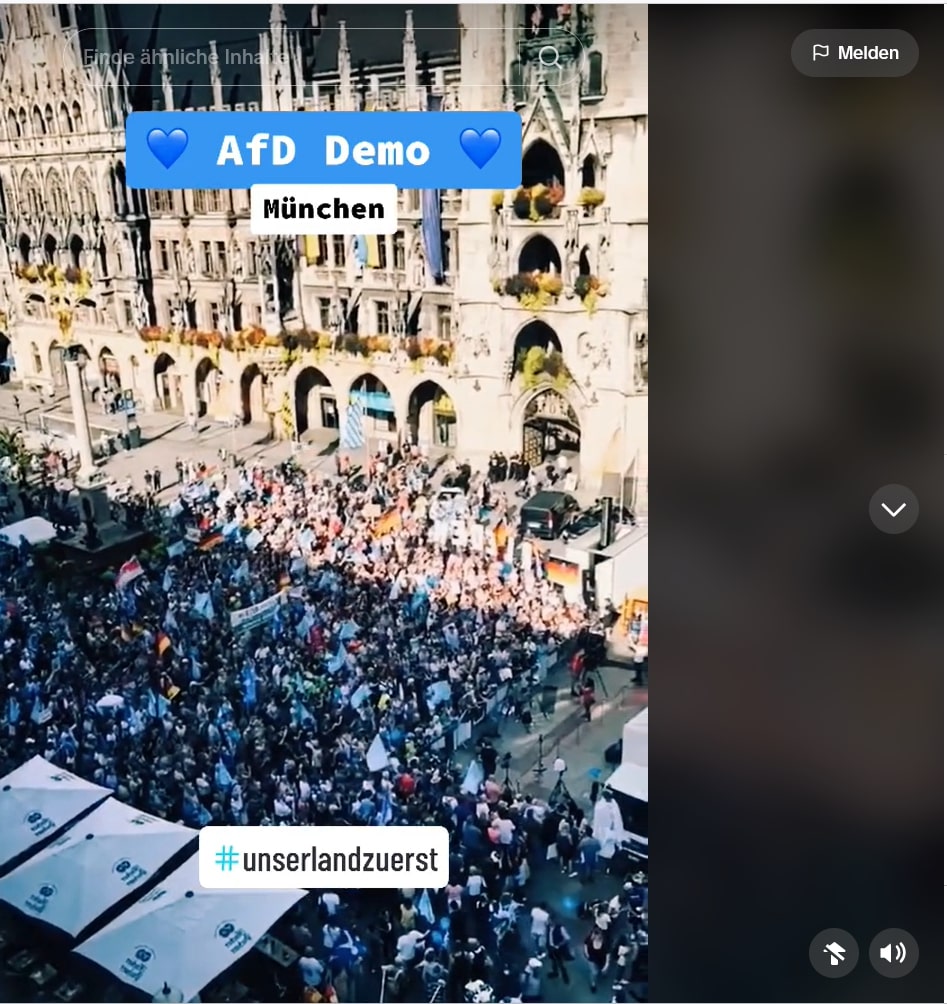
TikTok’s screenshot from AfD demonstration in Munich.
This is significant, as it indicates that AfD’s presence on TikTok has the potential to influence young voters. The party invests considerable resources into its social media accounts and tailors its parliamentary speeches for maximum impact on the platform.
According to an expert’s assessment, AfD operates its social media accounts with considerable resources, and members even write their parliamentary speeches with an eye toward TikTok virality. Disinformation is also spread by the party’s youth organization Junge Alternative (JA), which the German Federal Office for the Protection of the Constitution classifies as “certainly right-wing extremist,” and other right-wing extremist actors in the party’s front group.
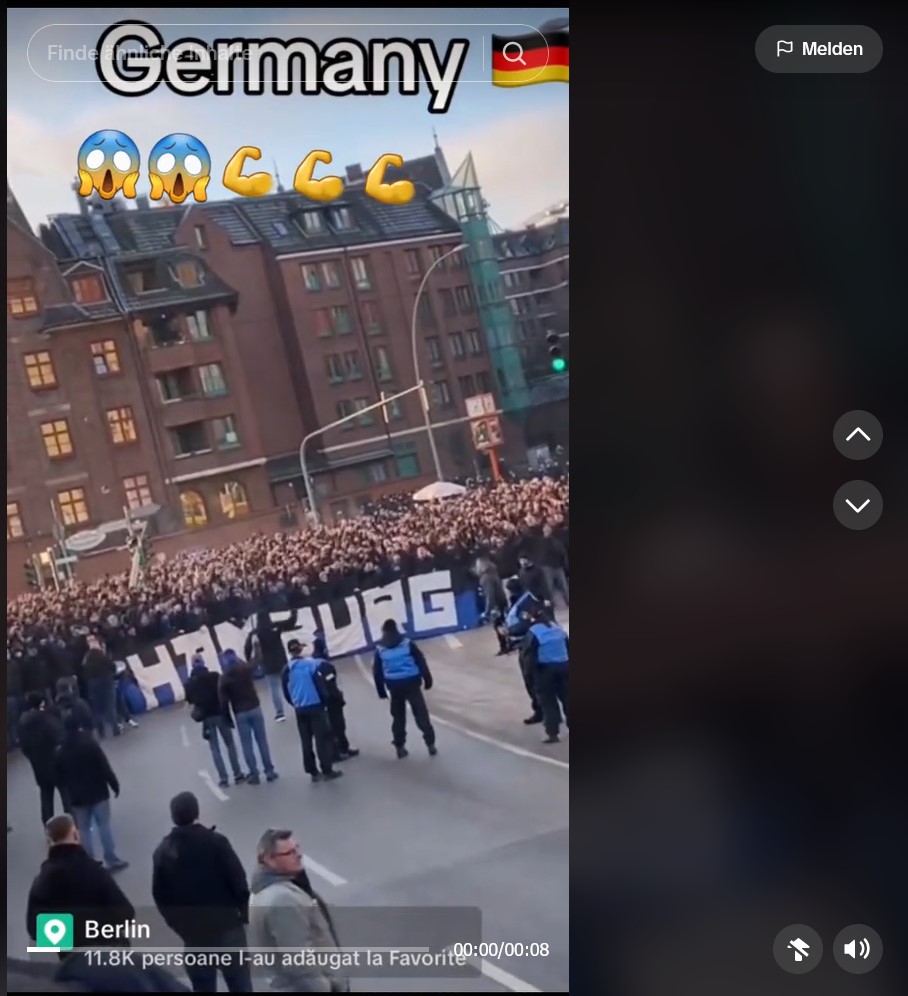
Excerpt from TikTok video showing AfD demonstration. Source: TikTok
One of AfD’s social media consultants was quoted in German media as saying that TikTok was “a window” into the “brain” of mainly young people.
Other parties, such as the relatively new Bündnis Sarah Wagenknecht (BSW), have challenged AfD’s dominance on TikTok. Our analysis of followership reveals that while not all AfD followers support BSW, a significant portion of BSW’s followers are also AfD supporters on TikTok.
Both parties performed relatively well in the recent European election, with AfD securing 15.9% of the national vote and BSW achieving 6.2%. The trend was even more noticeable in Eastern Germany, where AfD claimed nearly 30% of the vote. Critics argue that AfD’s popularity on platforms such as TikTok has contributed to the acceptance of political positions favoring Russia and against the support for Ukraine.
TikTok has responded to questions about AfD’s activity on the platform, stating that they have detected and removed networks that were artificially amplifying narratives favorable to AfD to influence Germany’s political discourse. TikTok also replied that they do not allow “the use of automation to register or operate accounts in bulk” or the distribution of high-volume commercial content.
Firehose of Falsehood is a joint investigation by 10 independent media outlets in the EU. The aim of the research was to analyze how malign content is spread on TikTok and who the main actors are. This is part of a continuing effort to track toxic content on social media following last year’s investigation into how similar content is spread on Facebook and Telegram.
The media partners of this investigation are: Investigace.cz (Czech Republic), FRONTSTORY.PL (Poland), ICJK (Slovakia), Átlátszó (Hungary), Delfi Estonia, DebunkEU.org (Lithuania), Westdeutscher Rundfunk (WDR, Germany), Oštro (Slovenia), Oštro (Croatia), Context.ro (Romania), and BIRD.BG (Bulgaria)
Pro-Russian propaganda on Czech TikTok
Olga is a young and charismatic influencer who captivates her Czech-speaking audience with her daily life in Moscow and impromptu street interviews. Her content, which includes luxury cars and bookstore reviews, subtly suggests that international sanctions have little impact on Russians’ lives, sparking curiosity about the people’s resilience.
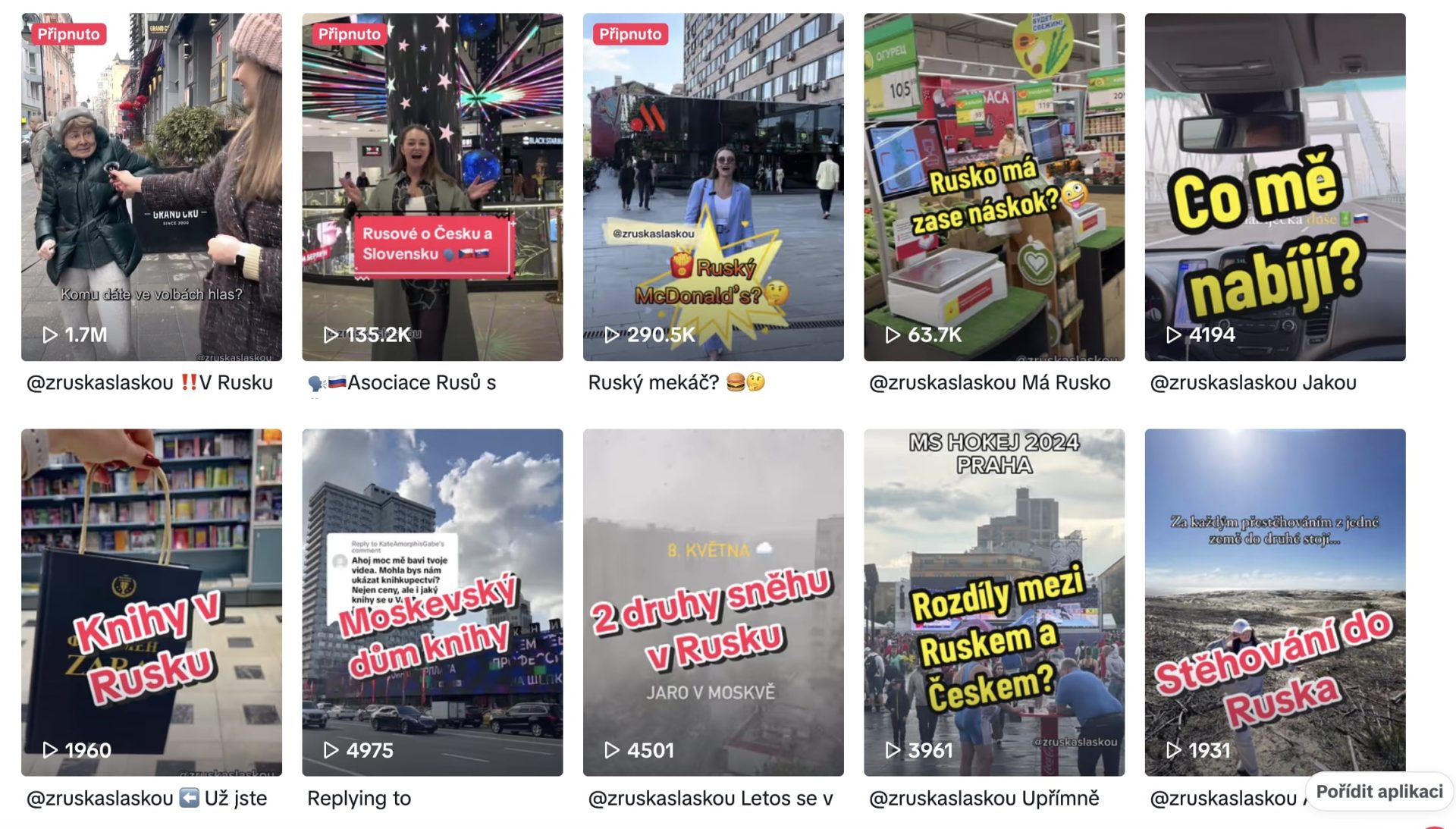
Olga says that she lived in the Czech Republic for 12 years before returning to Russia due to bureaucracy, poor service quality, and an increasing sense of lack of liberty in Europe. She runs the “Z Ruska s láskou” / “From Russia with love” TikTok account, which features Czech-language videos and reacts to current events in the Czech Republic. For instance, after Czech Prime Minister Petr Fiala’s comments on, Olga posted a video response in which she compared prices in Germany, the Czech Republic, and Russia to demonstrate that prices are lowest in Russia.
The “Z Ruska s láskou” account has over 10,000 followers and a diverse fan base. Investigace.cz analyzed 385 randomly selected followers as a sample and found that they also follow a range of popular overlapping accounts.
These include Czech and Slovak politicians like far-right leader Tomio Okamura and opposition politician and former Minister of Finance Alena Schillerová, a pro-Putin biker gang called “Brat za brata” (“Brother for Brother”), and an anonymous account named “pepekárna” that shares extremist content criticizing the Czech government and Ukraine and supporting fringe political parties.
TikTok’s algorithm is a powerful tool that swiftly gauges user preferences and promotes potentially viral content. In doing so, throughout the Czech Republic and Europe, it has also inadvertently allowed political activism, ideological extremism, hate speech, and propaganda to thrive on the platform. Understanding this phenomenon is a complex task, as TikTok’s data access for researchers is limited, necessitating a combination of API data, web scraping, and manual data collection for investigations.
About the fans of the rising star of Czech politics, Filip Turek, and TikTok you can read here.
New Romanian MEPs spread disinformation, conspiracies, Russian propaganda, and incite hatred
Claudiu Târziu, one of the newest Romanian members of the European Parliament, expressed concern about the European Commission’s alleged push towards a “federal superstate” in a TikTok video. He is affiliated with the Alliance for the Union of Romanians (AUR), which is considered an extremist right-wing party.
In this year’s elections, AUR won six seats, while another far-right party, SOS RO, won two seats. Claudiu Târziu, one of the leaders of the AUR party, is associated with a network of accounts that spreads disinformation, conspiracies, and Russian propaganda on TikTok, inciting hatred. Context.ro analyzed the content posted on TikTok by seven MEPs from AUR and SOS and found that 20 to 42% of their videos contained toxic messages.
Context.ro, with the help of two IT programmers, analyzed the video content.
The process of analyzing videos used to involve numerous manual steps, such as transcribing and reviewing the content to identify disinformation, manipulation, and aggressive language. However, Context.ro has developed software that automates this process, based on the model created by journalists and experts involved in the Firehose of Falsehood international investigation.
This software allowed us to analyze a much larger number of videos in a shorter time frame. We are continually working on improving this tool.
Context.ro utilized this software to examine videos posted on TikTok by 36 politicians running for the European Parliament. Out of more than 5,800 videos, 2,000 were found to contain exaggerations, fear-mongering, out-of-context information, or outright false content.
The analysis also revealed that candidates from these extremist parties — AUR and SOS — were the most active in spreading disinformation on TikTok. We specifically focused on studying the videos shared by these parties’ elected representatives to the European Parliament to understand the type of content they were posting.
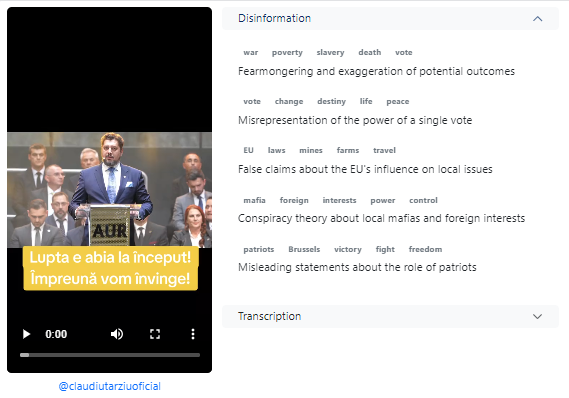
Excerpt showing the analysis of Claudiu Târziu’s video.
For instance, over 41% of Claudiu Târziu’s TikTok content was flagged by the software as disinformation. His videos included exaggerations, conspiracy theories, fear-mongering, xenophobic or homophobic messages, manipulation, and false information about EU policies.
The Polish far-right has won on TikTok
The Polish far-right alliance Konfederacja gained six seats in the European Parliament in the 2024 June elections, the third-best result of any party in Poland. This was a significant success compared to the 2019 EP elections, when no far-right party or politician was elected. Much of Konfederacja’s success is attributed to its outreach on social media, particularly TikTok, where it garnered substantial support from young people.
The most popular politician on Polish TikTok is Sławomir Mentzen, the 37-year-old leader of Konfederacja, who has over 850,000 followers. The official Konfederacja TikTok page also boasts 329,000 followers. Of the six newly elected members of the European Parliament from Konfederacja, two are also outstandingly popular on TikTok.
Interestingly, despite Konfederacja’s TikTok popularity, the newly elected candidates only launched their TikTok accounts in late 2022 or the first month of 2023. They actively posted during the parliamentary, local, and European elections in Poland, but after the electoral race, some politicians, like Anna Bryłka and Stanisław Tyszka, went silent.
Another MEP, Grzegorz Braun, known for his anti-Ukrainian campaigns and provocations in the Polish parliament, started his TikTok account at the beginning of 2023 and now has more than 100,000 followers, which, as in the case of Ewa Zajączkowska, corresponds with the number of votes received in the elections.
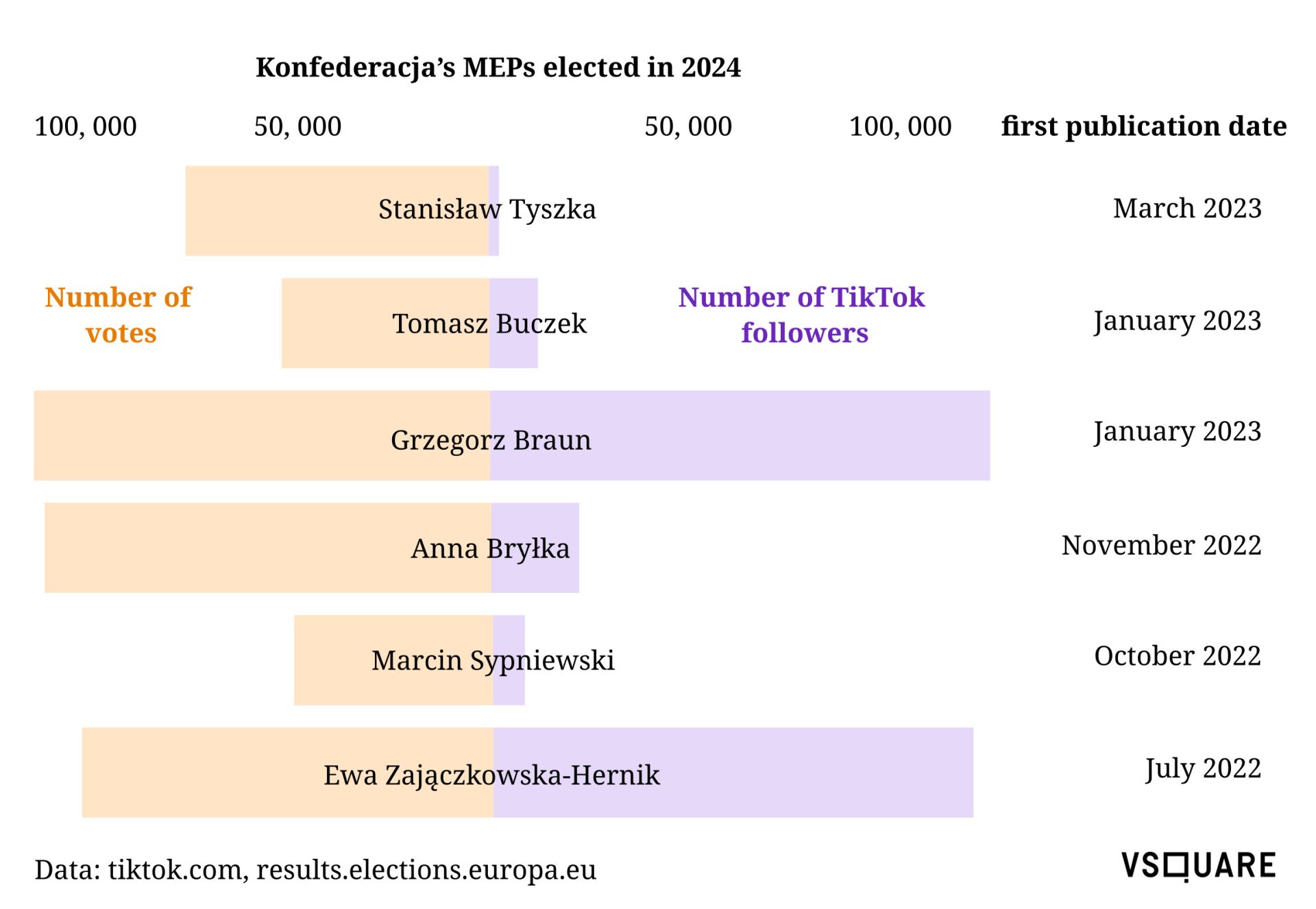
Konfederacja seems to have an active fan base on TikTok. For example, the “kamracki” and “jacekrogielski” accounts publish many video excerpts from Konfederacja’s politicians’ parliamentary speeches and invitations to protests. Interestingly, according to data we obtained from Tiktok, they are run in Polish but registered in Germany. (Out of about 200 accounts we researched, six were registered abroad, according to TikTok data. These were mostly anonymous accounts with a significant number of followers).
One of the most influential accounts promoting far-right agendas on Polish TikTok belongs to Stefan Tompson (more than 100,000 followers), a founder of the popular Visegrad 24 social media-based outlet and owner of a PR company operating in Poland. Visegrad 24 became an influential right-wing account on X, where it publishes positive content about Viktor Orbán or Donald Trump.
The account was reportedly the first international social media platform to publish a video of Finnish Prime Minister Sanna Marin dancing with friends at a house party in August 2022. That video created a political scandal at home for the Finnish PM. However, Tompson denied that the video first appeared on Visegrad 24.
The Fico assassination attempt fallout on Slovak TikTok
After the attempted assassination of Prime Minister Robert Fico, disinformation and groundless theories about the shooter began circulating in Slovakia. One example is a TikTok video in which former judge and unsuccessful presidential candidate Štefan Harabin (linked to nationalist politician SNS MP Roman Michelka) spread the conspiracy theory that the assassination was ordered by someone — and calling Zuzana Čaputová, the former president, “the ideological architect of the assassination.”
The TikTok video garnered 60,000 views, but it is important to note that TikTok does not have as wide a reach in Slovakia as Facebook, where political content also circulates. In Slovakia, TikTok users primarily seek entertainment and lifestyle content. Despite this, TikTok content related to the attempted assassination of Prime Minister Robert Fico was viewed by over 300,000 people.
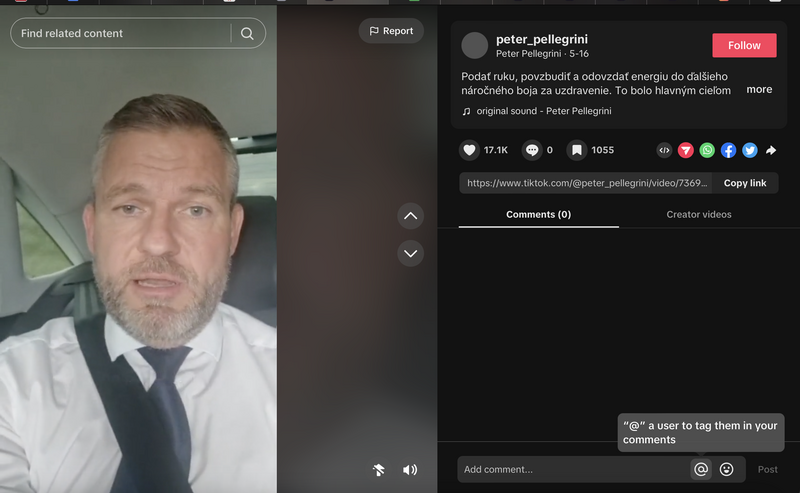
The most watched video about the assassination of Robert Fico is Peter Pellegrini on his way back from a hospital visit to the Prime Minister. Source: TikTok
The Investigative Center of Jan Kuciak (ICJK) analyzed the content spread on TikTok from May 15 to June 3, 2024, and found that the most-viewed posts were from politicians or political parties in the populist-nationalist ruling coalition. These included President Petr Pellegrini, the Smer party, and interior minister Matúš Šutaj Estok. Additionally, lesser-known or unknown profiles on TikTok have also reached a relatively large audience, spreading unsubstantiated opinions or outright conspiracies about the background of the assassin. For instance, a photo circulated on TikTok claiming that the attacker was standing at a protest next to the chairman of Progressive Slovakia, Michal Šimečka, and other people holding LGBTQ, transgender, and European Union flags. This photo was accompanied by the caption “Cintula and his friends. Šimečka and the terrorist.”
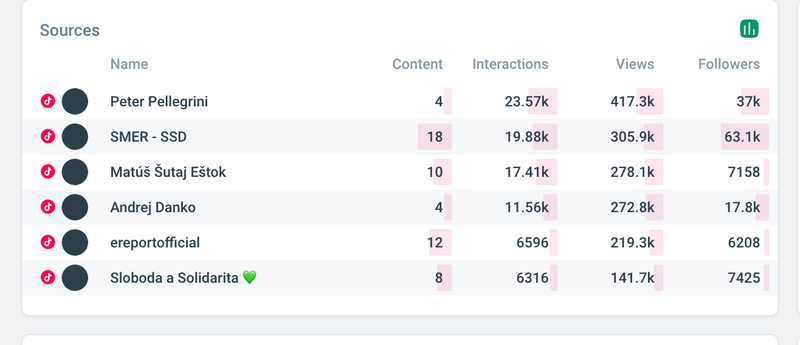
Russian narratives flow to TikTok via Hungarian state media
A peculiarity of Hungarian TikTok is that Russian disinformation content is disseminated not by marginal, but mainstream media sources. In this, social media is reflecting its more traditional counterpart: media sources affiliated with the Orbán government have for years wilfully amplified Russian propaganda narratives. In recent years, several TikTok accounts of dubious origin emerged to post videos clipped from news programs that convey Russian narratives. Thus, a typical Russian disinformation video on Hungarian TikTok is nothing more than a video clip from a television news program.
For example, more than 125,000 people follow a channel named “M1-Híradó.” Although the channel is named after the state news program, it is not officially affiliated with it. However, it publishes extracts from the news program, often including pro-Russian narratives.
Nearly 50,000 follow a similar account called “VILÁGHÍRADÓ ROLI OLDALA,” which republishes clips from news and political television programs and which, due to the nature of pro-government media, often contains news on foreign events with a Kremlin spin.
It should be noted that some channels officially associated with media figures also publish similar content: one such example is the account of Dániel Ferkó, a reporter of the pro-government Hír TV. His account also publishes clips from news programs, including such highlights as a report claiming that the March 22 Moscow terrorist attacks were actually organized by Ukrainian special services.
Similar reach is generated by the accounts of the Hungarian public media’s favorite “security policy experts” (Georg Spöttle, Robert Castel) who regularly promote the Russian narrative or share excerpts from their shows.- A major player in this genre is Ultrahang.tv, which is close to the Congregation of Faith, an Evangelical church with close ties to the government.
By contrast, channels affiliated with the traditional far-right fail to reach large audiences on Hungarian TikTok. The platform is used inconsistently by political figures and movements — for example, only one of the the top candidates from the three most successful parties in the recent EP elections has a TikTok channel. Although the Hungarian far-right has a long history online (in the 2000s and 2010s, right-wing extremism was largely an internet-based phenomenon), the traditional “national radical” subculture is less and less relevant in the current social media environment.
Although some of the most well-known far-right organizations and leaders have a presence on TikTok, their videos rarely get more than a few thousand views. Their content is posted irregularly, their videos are often long and they frequently fail to follow current trends.
The only exception to this is László Toroczkai, the leader of the far-right party Mi Hazánk, which received 6.71% of the votes in the recent EP elections. Toroczkai’s videos are extremely popular, reaching view counts comparable to some of the leading non-political channels. His most viewed video has over one million views.
Interestingly, Toroczkai is often able to attract large audiences not with typical far-right topics, but often by taking up issues that are traditionally associated with left-wing politics. His most watched video is of him denouncing the large oil firm MOL for what he claims is an illegal manipulation of consumer prices. Another video, which garnered around half a million views, is about motorway tolls, and a third is about the problem of poor quality imported honey flooding the Hungarian market.
Russian playbook and the high disinformation rate in Estonia
“Basically, I’m ready for the electricity to go out at any moment,” a young Estonian man shares in a fearful video. At first, his content seems to be expressing real concern about the possibility of an imminent war, but an investigation by Eesti Ekspress (Delfi) concluded that his stream of videos is part of the Estonian disinformation ecosystem — spreading on TikTok, one of the most popular networks in the country.
Every third Estonian is on TikTok, and an investigation by Eesti Ekspress conducted by scrolling through war-related conspiracy videos found that 63%of clips on the feed could be deemed disinformation. According to data from TikTok, there are around 400,000 Estonian users on the platform, which shows the platform’s significant popularity and influence in the country.
Eesti Ekspress journeyed into the disinformation corner of Estonian TikTok, aiming to unravel the mechanisms of information dissemination on the platform. The findings were alarming. Russian propaganda dominated Estonian users’ For You Pages, trying to spark a wave of anxiety and fear in the country.
Estonian reporters from Eesti Ekspress identified about 50 disinformation-related accounts, demonstrating a trend of monologue-type videos and “jokes” about how Estonia might be a battleground if the Russian war in Ukraine spreads.
For example, a video by a young Estonian boy asking, “Will you go to war if there is a war in Estonia?” garnered significant attention on Estonian TikTok. The video, posted in February, has accumulated over 46 thousand views, which is considered viral for a small country. In the six-minute video, the young man expresses his readiness for a potential war and blames Estonia’s government for the situation.
While some may interpret this as genuine fear or worry, the account’s other videos and their editing suggest otherwise.
“It’s crazy. I’ve been thinking about it for about a month, [I’ve] mentally prepared for it and trained. Basically, I’m ready for the electricity to go out at any moment,” the young man continued. The monologue gives the impression that he is convinced that war is coming soon and blames Estonia’s government.
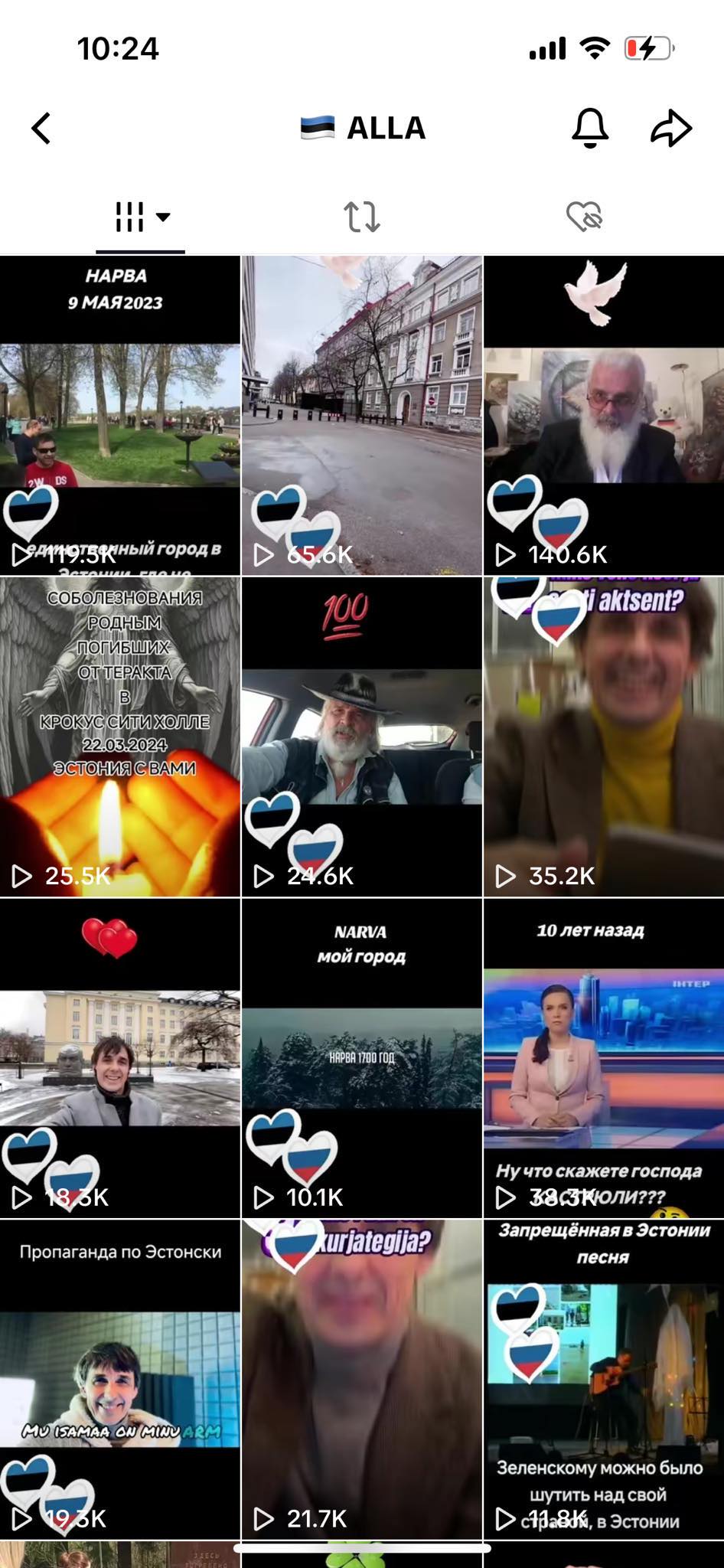
Popular videos on Estonian TikTok.
Upon further investigation, it became evident that the young man’s account was part of a disinformation campaign, as were other similar videos on TikTok. These videos suggested that a Russian attack was imminent and that NATO was sending troops to Ukraine, causing fear and anxiety — and inspiring further propagation of similar content.
Experts, including Maia Klaassen, a junior researcher of media literacy at the University of Tartu, warned that this tactic aligns with Russia’s longstanding strategy of sowing fear and uncertainty. There have been instances of bomb threats and misleading videos aimed at frightening people.
The investigation also revealed that most of the content that ended up on our feed consisted of propaganda or disinformation. This is circulating at a time when Estonian society is already experiencing higher levels of anxiety and fear of war. Active Estonian TikTok users spread this fear, inadvertently influencing Russia’s intentions.
TikTok’s reaction: “Misinformation is relatively rare on the platform”
TikTok, which is owned by Chinese tech company ByteDance, claimed in its answer to a series of questions we sent that it is efficient in combating disinformation on its platform. TikTok claims that it uses fact-checkers and is proactive in taking down harmful content. “As a factual note, misinformation is relatively rare on TikTok. In Q4 2023, of the 1% of videos removed for violating our Community Guidelines, less than 2% were removed for violating Integrity & Authenticity policies (and of that, less than 40% were removed for violating misinformation or civic integrity policies)”, a TikTok’s spokesperson shared in a written reply. The tech company also mentioned that it makes sure that toxic content is removed “completely, or in other more moderate instances, reducing its reach by making it ineligible for For You feeds.”
Tiktok denied that the platform has become a place where disinformation thrives and said that it has robust policies for the accounts belonging to politicians. “TikTok is an entertainment platform defined by the diversity of our community and the content they enjoy. We have robust policies for accounts belonging to a government, politician, or political party. These uphold our commitment to free expression while preventing misuse and preserving TikTok as a joyful platform that unites people, rather than dividing,” the company offered.
A Warsaw-based investigative and data journalist at VSquare and Frontstory.pl, Anastasiia Morozova previously collaborated with leading media outlets in Ukraine (Radio Free Europe, Slidstvo.info). She was shortlisted for the Grand Press Award (2022) and was a recipient of the Novinarska Cena 2022.
Josef Šlerka has worked as a data analyst and reporter at Czech Centre for Investigative Journalism since 2021. He used to head the Czech Fund for Independent Journalism (NFNZ). He is also the head of the Department of New Media Studies at Charles University in Prague.








